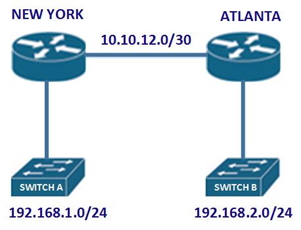Something new that you will see on the CCENT 100-101 exam and the CCNA 200-120 exam is the topic of Troubleshooting. I am very glad Cisco added troubleshooting to the CCNA exam series as it helps link the theory that you are learning along with how it actually works in the real world. IT really makes you think about how all the concepts work together and it helps you to be much more useful to the company that hires you if you have learned more than just the theory behind how routers work but you also have developed some troubleshooting skills.
So for our exam preparation question today we look at another scenario type question. These are quite common on Cisco CCNA exams as you can’t simply memorize an answer and you have to be able to interpet a topology drawing, review the router show output and apply it the scenario described in the question. So for the topology below, we have two routers of which one resides in New York and the other resides in Atlanta that are connected via a WAN link. Hanging off of each router we have a local subnet to that office.
Now refer to the exhibit and let’s analyze the output.

CCENT/CCNA Routing Question
| New_york#show ip route
Codes: C – connected, S – static, I – IGRP, R – RIP, M – mobile, B – BGP D – EIGRP, EX – EIGRP external, O – OSPF, IA – OSPF inter area N1 – OSPF NSSA external type 1, N2 – OSPF NSSA external type 2 E1 – OSPF external type 1, E2 – OSPF external type 2, E – EGP i – IS-IS, L1 – IS-IS level-1, L2 – IS-IS level-2, ia – IS-IS inter area * – candidate default, U – per-user static route, o – ODR P – periodic downloaded static route Gateway of last resort is not set 10.0.0.0/30 is subnetted, 1 subnets C 10.10.12.0 is directly connected, Serial0/0/0 C 192.168.1.0/24 is directly connected, FastEthernet0/0 S 192.168.3.0/24 [1/0] via 10.10.12.2
Router# |
A Cisco Certified Network Administrator is troubleshooting network connectivity problems. NEW YORK users on Switch A are complaining that they cannot access files stored on the server on Switch B in ATLANTA. The Atlanta Router is correctly configured and the administrator issues the show ip route command on router NEW_YORK. Based on the output above, what could be the problem?
A. The network has not fully converged.
B. IP routing is not enabled.
C. A static route is configured incorrectly.
D. The FastEthernet interface on Coffee is disabled.
E. The neighbor relationship table is not correctly updated.
F. The routing table on Coffee has not updated.
Explanation
This type of Cisco certification exam question really prepares you for the real world. It makes you string multiple concepts together to illustrate your mastery of the concepts. So as we take a look at the output above we see static routes. So since there are no dynamic routes via EIGRP, OSPF or such convergence is not the issue and answer A is incorrect.
Answer B is wrong since the output above showing static routes would not be present; only a default gateway. The fact that we have static routes means that ip routing is enabled.
Next we notice that the static route that has been configured is set to the 192.168.3.0 network. However, the network on switch B is 192.168.2.0. Therefore, this is an easy one and answer C is correct.
Answer D is wrong since the ip route output shows that the network connected to the fast Ethernet interface is connected.
The neighbor relationship is not applicable in this case and static routes converge very quickly more than dynamic routing protocols. So answer E and F are wrong.
So how do you practice CCENT and CCNA exam scenarios and topics like this? A common lab setup for the topology about would be two 1841 routers or similar with a WAN card like a wic-1t or wic-2a/s in each with a serial back to back cable connecting the two. Then any two switches like a 2950, 2960, 3550 or 3560 will work. There is nothing better than with real equipment like you will troubleshoot in the real world? Simulate this setup and go through the various possible answers to verify if they are right or wrong and really cement these concepts into your brain.
Don’t resort to CCNA brain dumps as that is not the way to learn the concept to pass your exam and get a job and keep the job. If you brain dump the exam, after you are hired your employer will find out very quickly you don’t have the skills to do the job and you will be fired. So impress prospective employers and tell them how you learned with your very own CCENT or CCNA home lab!
Please also see our Lab Suggestions and our CCENT & CCNA Lab Certification Kits
